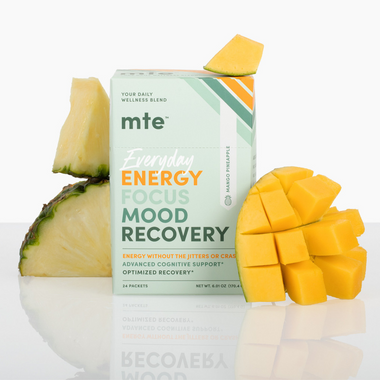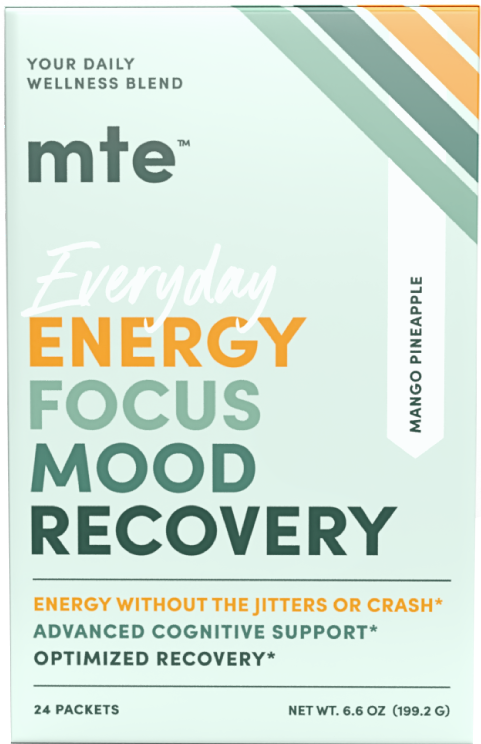
What Are Adaptogens? A Complete Guide to Anti-Stress Plants
In the age of mainstream biohacking and an almost psychotic focus on righting the wellness wrongs of a sedentary society that subsists on processed foods and 24/7 media consumption, chances are you’ve come across the word “adaptogen” by now. Often advertised as a natural way to reduce stress, there are plenty of health-food products like energy powders and ashwagandha tonics that purport adaptogenic benefits.
But what are those adaptogenic benefits? Are they even real or are we getting into some new-age hoo ha? And if they are legit, how, exactly, do adaptogens work? As a healthy alternative to energy drinks and coffee, MTE harnesses the power of adaptogens in our formula to promote stress resilience and more. After several years of obsessive research, collaborating with food scientists and nutritionists, and endless product testing,we know a thing or two about them.
So let’s get into it!
Understanding Adaptogens
Adaptogens are a class of herbs, mushrooms, algae, and plants that have bioactive properties that help the body adapt to physical and environmental stressors. While they’ve been used for millennia, the term wasn’t coined until the 20th century, when Russian scientists set out the official guidelines for a compound to be considered an adaptogen:
- Adaptogens must have a non-specific effect on the body, meaning that they can help the body adapt to a wide range of stressors, both physical and psychological.
- Adaptogens must have a normalizing effect on the body, meaning that they can help to restore balance to the body's systems, regardless of whether the body is in a state of hyper- or hypo-function.
- Adaptogens must be safe for human consumption, even when taken long-term.
While the effects of an adaptogen may be non-specific, we do know that the main functions they perform deal with the HPA axis, which is the body’s stress response control system. But not just that - the HPA axis plays important roles in energy regulation, immune function, sleep health, digestion, and mood. We’ll get to how and why in a minute.
There are 3 different classes of adaptogens, defined by the type/extent of their bioactivity:
- Primary adaptogens: These satisfy all three criteria and directly influence the HPA axis.
- Secondary adaptogens: These don’t influence the HPA axis directly but have an effect on the nervous, immune, and endocrine systems.
- Adaptogen companions: These are not technically adaptogens, but they have the ability to work in tandem with adaptogens to support their effects on the HPA axis.
Any part(s) of a plant can have adaptogenic properties – sometimes it’s the roots, other times the stems, leaves or fruits. However, the bioactivity of each part of the plant may be different - even dangerous. For instance:
- Ashwagandha: The roots are full of adaptogenic benefits like stress resilience, mood enhancement, and a natural energy boost. But the high concentration of withanolides in the berries and leaves will almost certainly make you throw up.
- Gingko: The leaves of this adaptogen are neuroprotective, support cognition, and improve circulation. But the raw seeds contain gingkotoxin, which can cause neurotoxicity and seizures.
- Aconite: Literally every part of this plant will m*rder you if not processed properly because of the aconitine. But if processed extensively, the roots boost immunity and relieve pain. Probably just, like, stay away from this one. Seems a little unnecessary.
Today, you can find adaptogenic supplements (from the right parts of the plants, don’t worry!) in drink, capsule or powder form, or even as a side dish – like lion’s mane mushroom. More on that later.
A Brief History of Adaptogens
Adaptogenic plants have 6000+ years of experiential evidence behind them before they even hit the modern West’s radar. Origins of many adaptogens trace back to Asia and South America, especially traditional Ayurvedic Indian medicine and Traditional Chinese Medicine. Three of the oldest-known adaptogens are:
- Ashwagandha: An adaptogen traditionally used in Ayurveda for things like skin problems, childhood illness, immunity, vitality, and sexual performance
- Reishi mushroom: An adaptogen traditionally used in Chinese medicine for things like immunity, inflammation, stress relief, liver function, and cancer treatment
- Eleuthero (Siberian ginseng): An adaptogen traditionally used in Russian medicine for things like insomnia, cholesterol, blood pressure, fatigue, and cognitive performance.
And in fact, it was a Russian scientist looking for a supplement that would make soldiers perform better, who officially coined the term “adaptogen” in the '40s while researching the capabilities of eleuthero.
How Adaptogens Work
Adaptogens have broad-spectrum abilities due to their effects on the HPA axis. The HPA axis is comprised of the hypothalamic, pituitary and adrenal systems. Via neurochemical signaling, the HPA axis functions as the body’s main stress response system. This includes any type of stress — mental, environmental, and physical. And it includes any level of stress — from life-and-death moments to chronic unease at work.
When your body responds to a stressor, a chain reaction occurs:
- The hypothalamus releases the CRH hormone to the pituitary gland.
- CRH tells the pituitary gland to release ACTH into the bloodstream.
- Some of that ACTH finds its way to the kidneys and adrenal gland, where it signals the adrenal gland to release cortisol, which is the body's stress-response hormone.
- The rush of cortisol and associated chemicals provides the extra energy, alertness and focus you need to overcome the stressful event.
Here's where the problem steps in: the human stress response doesn’t mesh with the modern day, because we aren’t dealing with episodic life-and-death stress; we’re dealing with chronic low-grade stress. That means the sympathetic nervous system is always on guard, preventing the parasympathetic nervous system from telling it to calm down again. Chronic raised levels of stress indicators in the body can have devastating effects on long-term health.
Adaptogens work to modulate and lower HPA activity to help the body resist stressors. Instead of the big energy spike and the bigger crash rebound, adaptogens smooth out the entire process, resulting in a more resilient stress response that’s less hard on your mind and body.
The effects adaptogens have on the body are typically grouped into one or more of three categories:
- Modulatory effect: Adaptogens can help to modulate the body's stress response, helping to reduce the negative effects of stress on the body.
- Prophylactic effect: Adaptogens can help to protect the body from the damaging effects of stress.
- Restorative effect: Adaptogens can help to restore the body's energy levels and vitality after periods of stress.
Because stress affects every part of our body, it follows that the benefits of adaptogens have the ability to support about every part of our body as well. Benefits of adaptogens include:
- Reduced stress and unease
- Improved rest and recovery
- Increased energy levels
- Improved focus and cognition
- Reduced inflammation
- Enhanced immune function
- Improved athletic performance
- Increased longevity
Key Adaptogens in MTE’s Energy-Boosting Greens
Our formula contains carefully-chosen adaptogens that work together to promote energy, mood, immunity, quality rest, and, of course, stress. And the cool thing about adaptogens is that, since each has a spectrum of abilities, stacking adaptogens adds to more than the sum of its parts. The adaptogenic herb blend in our energy supplement drink include:
Ashwagandha
Medicinal use of ashwagandha dates back to 3000 BCE Sumer, where it was used for strength and vitality. One of the most integral adaptogens in Indian Ayurveda, modern clinical studies on the abilities of ashwagandha show:
- It’s safe
- It has anti-carcinogenic effects
- It supports brain health
- It reduces chronic overthinking and emotional distress
One compelling study in the research on ashwagandha’s stress-reducing abilities showed ashwagandha supplements functioned as well as a common prescription for GAD.
Clinical research is also exploring ashwagandha’s potential for:
- Sleeplessness and chronic fatigue
- Joint pain
- Blood sugar management
- Metabolic function and diabetes
- Executive function
Eleuthero
Also known as Siberian ginseng, this cousin of panax ginseng has been used for at least 2600 years, and possibly up to 5000, but the first concrete evidence is a document from the Tang Dynasty in China. As the “first” adaptogen studied in a Western context, 80 years of clinical research has culminated in an official acknowledgement by the World Health Organization. On eleuthero, WHO acknowledges eleuthero:
“As a prophylactic and restorative tonic for enhancement of mental and physical capacities in cases of weakness, exhaustion and tiredness, and during convalescence.”
Modern studies support eleuthero’s abilities to reduce effects of oxidative stress, environmental stress, cognitive stress, increase resistance to toxicity, and improve the body's nightly restorative processes.
Maca
Medicinal and dietary use of maca originates about 6000 years ago in the Andes of Peru, but is grown all over the world today. Traditional uses include to promote fertility, reduce stress and improve endurance, strength and cognition. Today, there’s literature to support the adaptogenic abilities of maca:
- Reduces the effects of stress
- Eases experiences associated with mood deficiencies
- Supports sexual health and libido
- Promotes male fertility
- Boosts energy levels
- Enhances physical performance
Plus, maca is also a superfood, so you can choose to add it to your diet or to your wellness supplement routine. Reduced stress and increased nutrition? Sounds legit to us.
Along with 4 proven nootropics and 3 stalwart superfoods, MTE harnesses the combined powers of these clinically-backed adaptogens to support stress resilience, calm mood, balanced energy, rest and recovery at night, immunity, inflammation, and more. Nature’s already given us all the stuff we need to feel great – we’ve just gathered the best of it in a convenient caffeine-free energy powder so you can get it all in one spot. It’s more than an energy powder, really — it’s a feel-good drink — a daily companion that helps you be your best self without the caveats of chemicals, caffeine, and sugar.
Want to know more? Explore our Ingredients and Benefits pages for in-depth information on MTE’s formulation, and visit our Wellness Blog for more insight into adaptogens, nootropics, lifestyle, and more.






